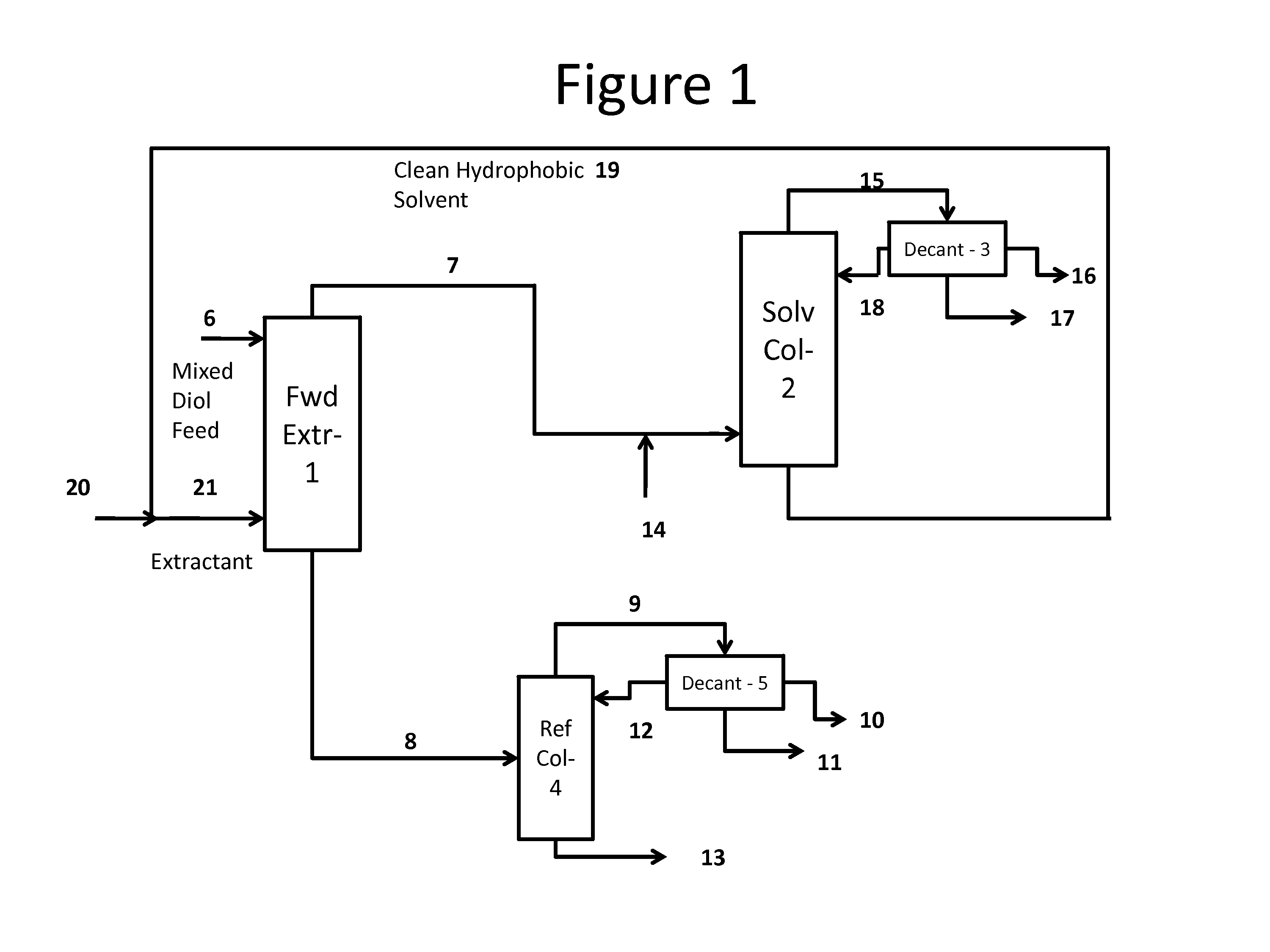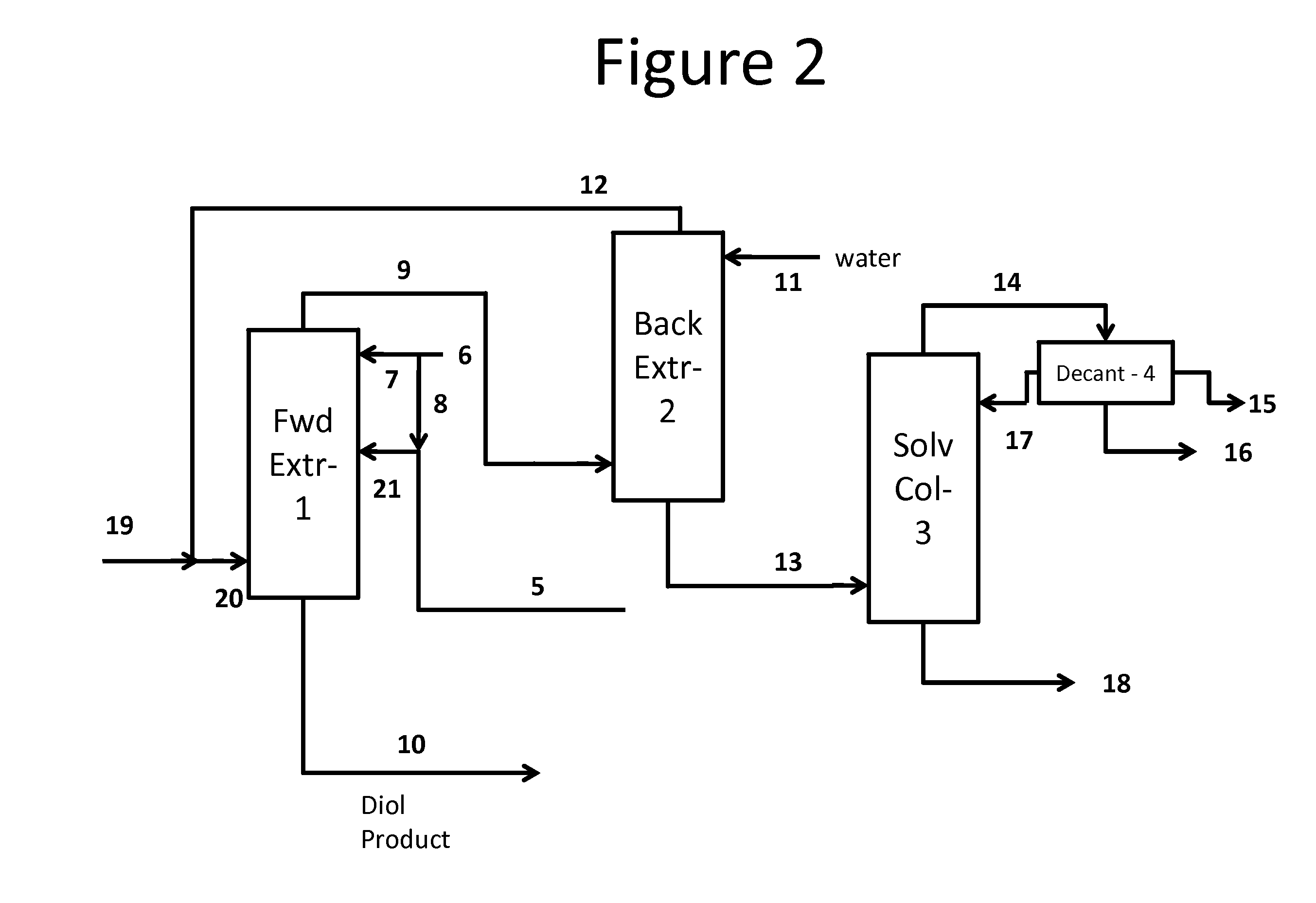Process for the separation and purification of a mixed diol stream
a technology of mixed diol and purification method, which is applied in the direction of organic compound/hydride/coordination complex catalyst, physical/chemical process catalyst, bulk chemical production, etc., can solve the problems of difficult separation of such mixed diol streams into pure fractions, and the difficulty of distillation, a common separation method, can prove difficult, and achieve the effect of efficient separation into component fractions
- Summary
- Abstract
- Description
- Claims
- Application Information
AI Technical Summary
Benefits of technology
Problems solved by technology
Method used
Image
Examples
example 1
[0236]Synthesis of pentaerythrityl trichlorohydrin (IX)— A five liter three neck round-bottom flask equipped with an overheard stirrer, a condenser (with a nitrogen purge and a Vigreux column to scrub off any sulfur dioxide), a “Y” connector, with a thermocouple in one side and an addition funnel in the other, was charged with 417 g (3.00 mol) of pentaerythritol and 730 g (9.24 mol) of pyridine. With vigorous stirring, 1134 g (9.24 mol) of thionyl chloride was charged drop wise over a period of 3 hours and 45 minutes and the mixture was heated to 125° C. and held at 125° C. overnight. The brown-yellow solution was cooled to room temperature and 2 L of cold, deionized water was charged with stirring. The precipitate was filtered and washed with 2.5 L of cold, deionized water. The vacuum-dried crude product, (459.7 g), a 1:3.1 mixture of pentaerythrityl trichlorohydrin (VIII) and pentaerythrityltetrachloride (IX) as determined by NMR, was separated using fractional distillation under ...
example 2
[0239]Hydrogenation of Glycolic Acid and Glycolate Esters—A mixture comprising 70 ml ethylene glycol, and 6 mL of the glycolic acid / ester feed mixture described above, containing 5 weight percent water, and (2-(butoxymethyl)-2-((diphenylphosphino)methyl)propane-1,3-diyl)bis(diphenylphosphine)ruthenium diacetate (referred to herein as “(BuO-triphos)Ru(OAc)2”) at a concentration of 100 ppm Ru metal was loaded into a high pressure Hastelloy C autoclave. The autoclave, nominally 100 mL volume, was fitted with a Rushton turbine impeller, baffles, thermowell, and gas inlet tube. The reactor vessel was heated electrically to 190° C. by a band heater, with temperature control provided by feedback via a K-type thermocouple in the autoclave thermowell. Pure hydrogen gas (>99.9 volume %) was fed to the autoclave via a Brooks flow controller, with pressure maintained at 124.1 bars gauge (1800 psig). After the initial charge, a stock solution of the glycolic acid / ester feed mixture described abo...
example 3
[0240]This example illustrates the effect of water content in the glycolic acid hydrogenation effluent feed mix and the effect of hydrocarbon content of the extractant on extraction of ethylene glycol, 1,2-butanediol (BDO), and 1,2-propanediol (PDO). In Experiments 3-1 to 3-20, water was added to the reactor effluent generated in Example 2 to give the water content specified in Table 1. In addition, 1 weight percent (on an undiluted reactor effluent basis) each of BDO and PDO was added to the reaction effluent of Example 2. The resulting mixtures were contacted (i.e., mixed vigorously) with a solvent mixture comprising 2-ethylhexanol and heptane in the composition and solvent to feed (S / F) ratio specified in Table 1. Each mixture was held at 60° C., allowed to separate into two clear phases and analyzed by GC to determine EG, 1,2-PDO, 1,2-BDO weight percentages which were used to calculate partition coefficients (P) of ethylene glycol, 1,2-BDO, and 1,2-PDO and selectivities between ...
PUM
| Property | Measurement | Unit |
|---|---|---|
| Temperature | aaaaa | aaaaa |
| Temperature | aaaaa | aaaaa |
| Percent by mass | aaaaa | aaaaa |
Abstract
Description
Claims
Application Information
 Login to View More
Login to View More - R&D
- Intellectual Property
- Life Sciences
- Materials
- Tech Scout
- Unparalleled Data Quality
- Higher Quality Content
- 60% Fewer Hallucinations
Browse by: Latest US Patents, China's latest patents, Technical Efficacy Thesaurus, Application Domain, Technology Topic, Popular Technical Reports.
© 2025 PatSnap. All rights reserved.Legal|Privacy policy|Modern Slavery Act Transparency Statement|Sitemap|About US| Contact US: help@patsnap.com



